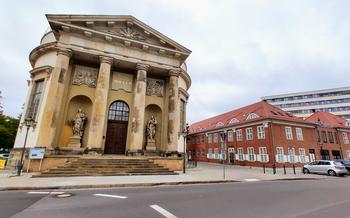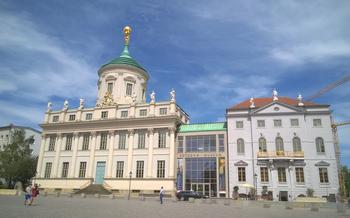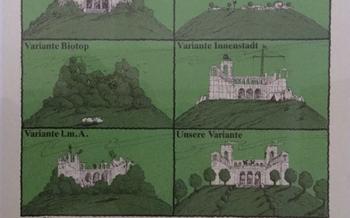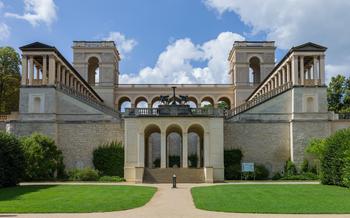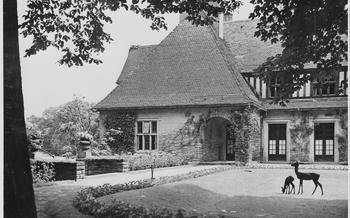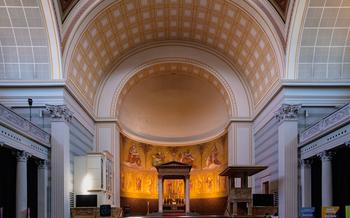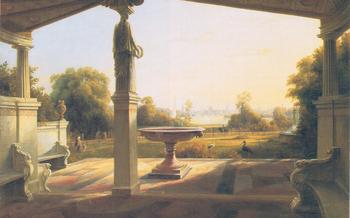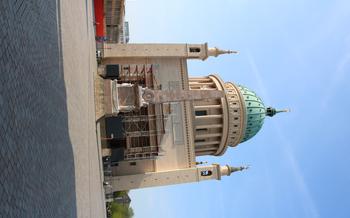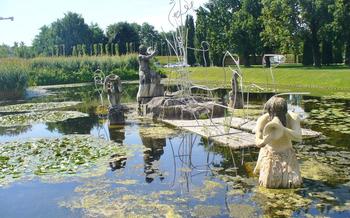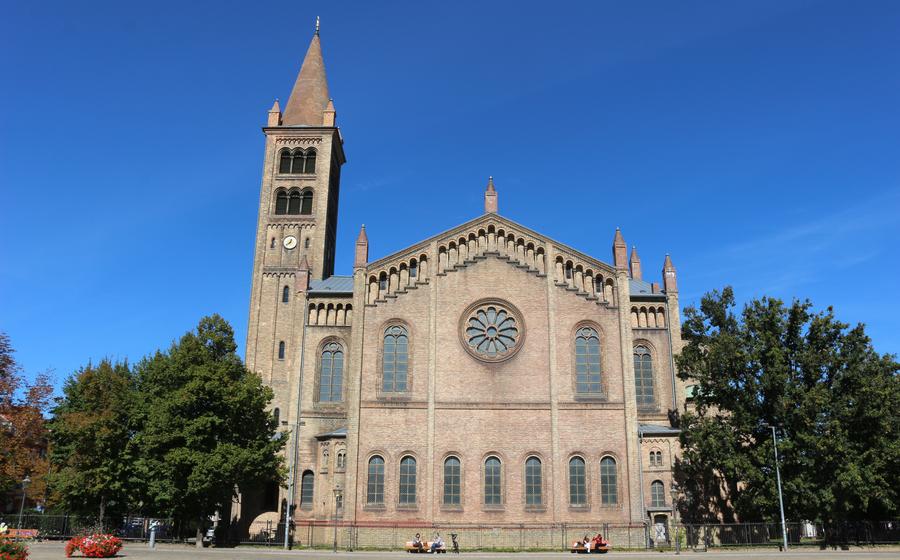
The St. Peter and Paul Church
- The St. Peter and Paul Church: A Historical Overview
- Exploring the Church's Interior
- The Church Tower: A Symbol of Potsdam
- The Church's Connection to the Royal Family
- The Churchyard: A Peaceful Retreat
- Attending a Service or Concert
- Visiting the Church Museum
- Getting to the St. Peter and Paul Church
- Tips for Photography Enthusiasts
- The Church's Role in Potsdam's Cultural Scene
- The Church's Contribution to the Community
- The St. Peter and Paul Church in Literature and Art
- Legends and Folklore Surrounding the Church
- Insider Tip: Hidden Gem in the Churchyard
The St. Peter and Paul Church: A Historical Overview
The St. Peter and Paul Church, a majestic edifice in Potsdam, Germany, stands as a testament to the city's rich history and architectural prowess. Its construction, initiated in 1869 under the reign of King Wilhelm I, was entrusted to the renowned architect Friedrich August Stüler, who envisioned a neo-Romanesque masterpiece. The church's inauguration in 1872 marked a significant milestone in Potsdam's urban development, forever etching its presence onto the cityscape.
Architectural Style and Unique Features:
A harmonious blend of Romanesque and Byzantine architectural elements characterizes the St. Peter and Paul Church. Its imposing facade, adorned with intricate carvings, arches, and a rose window, exudes an aura of grandeur. The interior captivates with its soaring vaulted ceilings, elegant pillars, and vibrant stained-glass windows that bathe the sanctuary in an ethereal glow.
Significance and Cultural Impact:
Beyond its architectural significance, the St. Peter and Paul Church holds immense cultural and historical value. It represents the Prussian monarchy's patronage of the arts and their desire to create a lasting legacy in Potsdam. The church's grand dimensions and elaborate decoration reflect the Hohenzollern dynasty's power and prestige, while its prominent location in the city center underscores its symbolic importance.
Role in the Potsdam Cityscape:
The St. Peter and Paul Church stands as a focal point within Potsdam's urban landscape. Its towering presence dominates the skyline, visible from various vantage points across the city. The church's architectural grandeur complements the surrounding historical buildings, creating a harmonious ensemble that reflects Potsdam's rich heritage.
Exploring the Church's Interior
Step inside the St. Peter and Paul Church, and prepare to be awestruck by its opulent interior. Gaze upon the stunning frescoes and paintings that adorn the walls and ceiling, depicting biblical scenes and the life of Jesus Christ. Admire the intricate carvings and sculptures that grace every corner of the church, showcasing the incredible skill and artistry of the craftsmen who created them.
The grandeur of the altar and pulpit is simply breathtaking. The altar, a masterpiece of Baroque artistry, is adorned with intricate carvings, gold leaf, and precious stones. The pulpit, equally impressive, features a beautifully carved canopy and a sounding board decorated with cherubs and angels.
But perhaps the most impressive feature of the church's interior is its magnificent organ. With over 3,000 pipes, this awe-inspiring instrument fills the church with its majestic sound, creating an unforgettable acoustic experience. Attend a concert here, and let the music transport you to another realm.
The Church Tower: A Symbol of Potsdam
The towering steeple of the St. Peter and Paul Church is an iconic landmark that defines the Potsdam skyline. Constructed in the 19th century, the tower stands at an impressive 60 meters (197 feet) tall and has become a cherished symbol of the city. Its distinctive neo-Gothic design, with intricate carvings and elaborate ornamentation, reflects the architectural grandeur of the period.
Ascend the narrow spiral staircase to reach the viewing platform at the top of the tower. The climb is well worth the effort, as you'll be rewarded with breathtaking panoramic views of Potsdam and its surrounding landscapes. Gaze out over the city's rooftops, admire the tranquil waters of the Havel River, and spot landmarks like the Sanssouci Palace, the Orangery, and the Glienicke Bridge.
Admire the unique architectural elements of the tower as you climb. Note the intricate carvings on the exterior, depicting biblical scenes and figures. Observe the transition from the square base to the octagonal upper section, which lends a dynamic character to the structure. Take a moment to appreciate the craftsmanship and attention to detail that went into its construction.
The Church's Connection to the Royal Family
The St. Peter and Paul Church holds a significant place in the history of the Hohenzollern dynasty, the former ruling family of Prussia and Germany. The church served as their primary place of worship and was closely associated with important royal events and traditions.
The Hohenzollerns played a crucial role in the construction of the church, providing financial support and ensuring its grandeur and opulence. They viewed the church as a symbol of their power and authority, and many members of the royal family were baptized, married, and buried within its sacred walls.
Several royal weddings took place at the St. Peter and Paul Church, including the marriage of Frederick William IV and Elisabeth Ludovika of Bavaria in 182The church also hosted numerous christenings of royal children, including the baptism of Kaiser Wilhelm II in 185
Within the churchyard, visitors can find the Mausoleum of Frederick William III and Queen Louise, an impressive neoclassical structure that serves as the final resting place of the beloved Prussian monarchs. The mausoleum is a testament to the deep affection and respect that the Hohenzollerns held for their ancestors.
The St. Peter and Paul Church is steeped in stories and anecdotes related to the royal family. One famous tale recounts the ghost of Queen Louise, who is said to haunt the churchyard, searching for her lost son.
The church's connection to the Hohenzollerns adds a layer of historical intrigue and significance to its already impressive stature. Visitors can immerse themselves in the stories of the Prussian monarchy and gain insights into the lives of the powerful figures who shaped Germany's past.
The Churchyard: A Peaceful Retreat
The churchyard surrounding the St. Peter and Paul Church exudes a serene atmosphere, inviting visitors to pause and reflect amidst its beautifully landscaped grounds. Stroll along the winding paths, admiring the meticulously maintained gardens and the towering trees that cast a dappled shade over the tranquil space.
Notable graves and memorials grace the churchyard, paying homage to prominent figures who shaped Potsdam's history. Among them, you'll find the final resting place of the renowned architect Karl Friedrich Schinkel, whose visionary designs left an indelible mark on the city's architectural landscape.
The churchyard also holds historical significance, serving as a poignant reminder of the turbulent events that unfolded in Potsdam. During the devastating air raids of World War II, the church suffered significant damage, and the churchyard became the final resting place for many who lost their lives in the conflict.
Today, the churchyard stands as a testament to the resilience and unwavering spirit of Potsdam's people. It serves as a serene sanctuary, inviting visitors to contemplate the past, honor the memory of those who came before, and appreciate the enduring beauty of this sacred space.
Attending a Service or Concert
The St. Peter and Paul Church is not only a historical landmark but also a vibrant place of worship and cultural events. Attending a service or concert at the church is a unique and enriching experience.
For those wishing to attend a religious service, the church offers a variety of services throughout the week. Visitors are welcome to join the local congregation for prayers, hymns, and sermons. The church's beautiful interior and impressive acoustics create a truly inspiring atmosphere for worship.
The church also hosts regular concerts and musical events, showcasing the talents of local and international musicians. The church's excellent acoustics make it an ideal venue for concerts of classical music, choral performances, and organ recitals. Attending a concert at the St. Peter and Paul Church is a fantastic opportunity to experience the church's stunning architecture and acoustics while enjoying beautiful music.
Before attending a service or concert, it is advisable to check the church's website or contact the church office for the schedule of events and any specific dress code requirements.
Visiting the Church Museum
Delve into the rich history of the St. Peter and Paul Church and the Hohenzollern dynasty at the on-site museum. This treasure trove of artifacts and exhibits offers a fascinating glimpse into the lives and times of those who shaped Potsdam's past.
Discover intricate artifacts, historical documents, and personal belongings that shed light on the church's construction, royal patronage, and cultural significance. Learn about the Hohenzollern family's deep connection to the church and their role in shaping its architectural and artistic legacy.
Interactive displays and educational programs bring the church's history to life, making it an engaging experience for visitors of all ages. Explore the museum's collection at your own pace or join a guided tour to gain deeper insights into the stories behind the artifacts.
The church museum plays a crucial role in preserving the legacy of the St. Peter and Paul Church and ensuring that its historical significance continues to inspire future generations.
Getting to the St. Peter and Paul Church
The St. Peter and Paul Church, a prominent landmark in Potsdam, is conveniently located in the heart of the city, making it easily accessible by various means of transportation.
Public Transportation: - Potsdam is well-connected by an efficient public transportation network, including buses and trams. - Visitors can take bus lines 605 or 695 and get off at the "Peter-und-Paul-Kirche" stop, which is just a short walk from the church.
Train: - Potsdam Hauptbahnhof (main train station) is a major transportation hub, offering regional and long-distance train connections. - From the train station, visitors can take a short walk or catch a bus or tram to reach the church.
Parking: - For those arriving by car, limited parking spaces are available in the vicinity of the church. - It is recommended to arrive early or consider using public transportation to avoid parking challenges.
Guided Tours and Tour Options: - Guided tours of the St. Peter and Paul Church are available in various languages, providing visitors with in-depth insights into its history, architecture, and significance. - Visitors can join group tours or book private guided tours to suit their preferences and interests.
Tips for Photography Enthusiasts
The St. Peter and Paul Church presents a picturesque subject for photography enthusiasts, with its intricate architecture, stunning frescoes, and serene churchyard. To capture the church's beauty, consider the following tips:
-
Golden Hour Magic: Plan your visit during the golden hours of sunrise or sunset to harness the warm, diffused light that enhances the church's facade and surrounding landscapes.
-
Interior Masterpieces: Use a wide-angle lens to capture the grandeur of the church's interior, ensuring you include the intricate frescoes, ornate carvings, and the impressive altar.
-
Towering Perspectives: For a unique perspective, climb the church tower to capture panoramic shots of Potsdam's cityscape, with the church as the focal point.
-
Silent Serenity: Visit the churchyard during quieter hours to capture its peaceful ambiance, focusing on the delicate details of the gravestones and sculptures.
-
Respectful Photography: Remember that the church is an active place of worship, so be respectful of ongoing services and events. Silence your camera shutter and avoid using flash photography.
-
Instagram-Worthy Spots: Don't miss the Instagram-worthy spots within the church, such as the intricate carvings on the pulpit, the colorful stained glass windows, or the serene reflection of the church in the nearby water bodies.
The Church's Role in Potsdam's Cultural Scene
The St. Peter and Paul Church is not merely a religious site but also a vibrant cultural hub, contributing to Potsdam's rich tapestry of arts and culture. The church regularly hosts concerts, exhibitions, and cultural events, showcasing the talents of local and international artists. From classical music concerts to contemporary art exhibitions, the church's diverse offerings cater to varied tastes and interests.
The church's exceptional acoustics make it an ideal venue for musical performances, attracting renowned musicians and ensembles from around the world. Visitors can immerse themselves in the harmonious melodies that reverberate within the church's hallowed walls, creating a truly immersive and unforgettable experience.
Beyond music, the church also serves as a platform for visual arts, hosting exhibitions that showcase the works of local and regional artists. These exhibitions provide a glimpse into the vibrant art scene of Potsdam, allowing visitors to appreciate the diverse range of artistic expressions and styles.
The St. Peter and Paul Church's commitment to culture extends beyond its own walls. The church actively collaborates with local artists and organizations, supporting and promoting artistic initiatives that enrich the cultural landscape of Potsdam. Through these collaborations, the church fosters a vibrant and dynamic cultural scene that celebrates the city's rich history and heritage.
The Church's Contribution to the Community
The St. Peter and Paul Church in Potsdam has a strong commitment to social and charitable work, actively contributing to the well-being of the local community. Through various initiatives, the church strives to make a positive impact on the lives of those in need. One significant aspect of its community involvement is its support for social welfare programs. The church collaborates with local organizations to provide assistance to the underprivileged, including food banks, homeless shelters, and counseling services.
Beyond its social welfare efforts, the church plays a vital role in preserving local traditions and fostering a sense of community. It hosts regular events and gatherings that bring people together, celebrating cultural heritage and strengthening bonds within the community. These events include traditional festivals, concerts, and workshops, providing a platform for residents to connect, share experiences, and learn from one another.
Furthermore, the church serves as a gathering place for various community events, such as weddings, funerals, and celebrations. These occasions not only reinforce the church's significance as a spiritual center but also underscore its role as a communal hub where people can come together to mark important moments in their lives. Through its diverse community engagement initiatives, the St. Peter and Paul Church demonstrates its commitment to fostering a socially responsible and vibrant community in Potsdam.
The St. Peter and Paul Church in Literature and Art
The St. Peter and Paul Church has been a source of inspiration for artists and writers throughout history, leaving an indelible mark on Potsdam's cultural heritage. In literature, Theodor Fontane, a renowned German novelist, immortalized the church in his 1896 novel "Effi Briest," where it serves as a backdrop for significant events in the protagonist's life.
In the realm of art, the church's captivating beauty has captivated the imaginations of painters, sketch artists, and photographers alike. Its striking silhouette and intricate details have been captured in numerous paintings and sketches, showcasing the church's architectural grandeur from various perspectives.
The church has also found its way onto the silver screen, featuring in several films and television shows. In the popular German TV series "Babylon Berlin," the church makes a notable appearance, adding historical authenticity to the show's depiction of 1920s Berlin.
Beyond these specific references, the church's enduring presence in Potsdam's cityscape has influenced the artistic and cultural landscape of the city as a whole. Its iconic status has made it a symbol of Potsdam, inspiring local artists and fueling the city's vibrant creative scene.
The St. Peter and Paul Church stands as a testament to the power of architecture to transcend its functional purpose and become a muse for artistic expression. Its enduring influence on literature and art speaks to its profound impact on the cultural fabric of Potsdam.
Legends and Folklore Surrounding the Church
The St. Peter and Paul Church is not only a historical and architectural marvel but also a place steeped in legends and folklore. One of the most famous tales is the ghost of Queen Louise, wife of King Frederick William III. It is said that her spirit roams the church at night, searching for her lost son, who died in infancy. Visitors have reported seeing her apparition in the church's hallways and hearing her soft footsteps echoing through the empty chambers.
Another legend tells of a secret tunnel connecting the church to the nearby Cecilienhof Palace. According to the story, the tunnel was used by the royal family to escape from the palace in times of danger. Some say that the tunnel still exists today, hidden beneath the streets of Potsdam, waiting to be discovered.
These are just a few of the many legends and stories associated with the St. Peter and Paul Church. Whether you believe in them or not, they add an air of mystery and intrigue to this already fascinating place.
Insider Tip: Hidden Gem in the Churchyard
Beyond the grandeur of the church itself, the churchyard holds a treasure trove of hidden gems waiting to be discovered. As you wander through the serene landscape, keep an eye out for forgotten sculptures and memorials that tell the stories of Potsdam's past.
One such gem is the grave of Heinrich von Kleist, a renowned German writer and playwright. His tombstone, adorned with a simple cross, stands as a testament to his literary legacy. Nearby, you'll find the resting place of Moses Mendelssohn, a prominent philosopher and father of the Haskalah, the Jewish Enlightenment movement. Mendelssohn's grave is marked by a stately obelisk, a symbol of his profound influence on Jewish thought.
As you explore further, you'll encounter other intriguing graves and memorials, each with a story to tell. Discover the final resting place of Friedrich August Stüler, the architect responsible for many of Potsdam's magnificent buildings, including the Church of Peace. Pay your respects to Hermann von Helmholtz, a renowned scientist and physician who made significant contributions to the fields of physiology and physics.
The churchyard of St. Peter and Paul Church is a place of remembrance and reflection, where the lives and accomplishments of prominent figures from Potsdam's history are honored. As you uncover these hidden gems, you'll gain a deeper appreciation for the rich tapestry of the city's past.
